Knee Arthroscopy
Updated:
(Also known as Arthroscopic Knee Surgery, Knee Arthroscope)
What is knee arthroscopy?
Knee arthroscopy is a minimally invasive surgical procedure that is used to investigate structures within the knee joint and treat a variety of knee conditions (such as a meniscal tear, ligament tear or knee arthritis). This is usually performed by inserting a small camera (arthroscope) into the knee joint via small incisions or portals (usually of less than 1cm in length). Other tiny instruments capable of cutting, shaving or repairing tissue within the knee joint may be inserted through other small incisions if required.
The knee joint primarily comprises of the union of two bones: the long bone of the thigh (femur) and the shin bone (tibia) (figure 1). The knee cap (patella) also sits on top of the femur forming the patellofemoral joint. Between the bone ends of the femur and tibia are 2 round discs made of cartilage called the medial (inner) and lateral (outer) meniscus (figure 1). Articular cartilage also lines the joint surfaces of the femur, tibia and patella. The articular cartilage and menisci act as shock absorbers, cushioning the impact of the bones on each other during weight-bearing activity. In addition, strong ligaments and connective tissue hold the bones of the knee together, giving it stability.
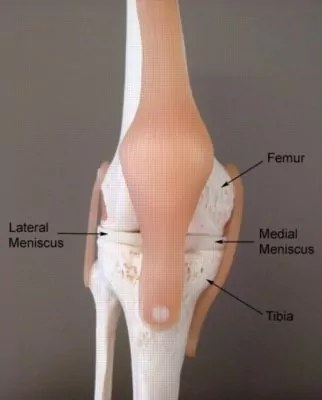
Structures within the knee (such as cartilage or ligaments) may be damaged due to overuse or trauma. Occasionally these injuries may be beyond the body’s healing capacity and may warrant the use of knee arthroscopy to assess or treat the condition. This may be particularly indicated in patients who have not responded to appropriate physiotherapy treatment and rehabilitation. For cartilage injuries (such as a medial meniscus tear) knee arthroscopy usually involves shaving and removing the torn cartilage. This restores the smooth surfaces of the joint and aims to preserve as much cartilage as possible for optimal shock absorption.
Knee arthroscopy is usually performed as a day procedure for patients who are having it as an investigative procedure or to treat torn cartilage within the knee.
Indications for knee arthroscopy
Knee arthroscopy may be indicated in patients with certain knee injuries, particularly those that do not respond to appropriate physiotherapy treatment and rehabilitation for their condition.
Knee arthroscopy may also be indicated as an investigative procedure to assess the integrity of structures within the knee such as the ligaments, menisci and articular cartilage. In this event, surgical treatment (such as trimming of a torn meniscus) may be indicated according to findings. Some of the more common conditions treated via knee arthroscopy include:
- medial meniscal tears
- lateral meniscal tears
- patella-femoral cartilage damage
- knee articular cartilage damage
- knee osteoarthritis
- ACL rupture
Although knee arthroscopy has traditionally been used to treat degenerative knee arthritis and degenerative meniscal tears, recent research suggests this procedure does not result in significantly improved outcomes (i.e. pain and function) compared to conservative management.
An orthopaedic surgeon can assess a patient and determine the suitability of knee arthroscopy based on a number of factors. Some of these may include:
- injury diagnosis and severity
- degree of pain and disability experienced by the patient
- patient age, occupation and activity levels
- expected symptomatic and functional improvement following surgery
- cost
Signs and symptoms following knee arthroscopy
Following knee arthroscopy, symptoms vary significantly from patient to patient depending on a number of factors such as:
- the severity of injury prior to surgery
- type of pain relief or anti inflammatory medication
- strength and flexibility of the knee prior to surgery
- age of the patient
- various psycho-social factors (see understanding pain)
- quality of rehabilitation following the procedure.
A small percentage of patients may experience little or no symptoms following knee arthroscopy and may only notice minor soreness or stiffness. This is usually the case in younger patients who have had minor meniscal damage and excellent strength and flexibility of the knee prior to surgery.
Patients usually experience swelling, pain and knee stiffness with symptoms ranging from mild to severe. Pain may be felt in the front, back or sides of the knee or occasionally the thigh, calf, ankle or foot. Symptoms typically increase with excessive twisting or weight bearing activity (especially walking up or down hills or on uneven surfaces or standing still for prolonged periods), when climbing stairs, attempting to kneel, or when squatting, lifting or carrying. The patient may also walk with a limp or be unable to weight bear due to pain. Symptoms may also increase with rest and may present as an ache, pain or stiffness that is particularly prominent at night or first thing in the morning.
Tenderness is usually experienced when firmly touching the knee joint line or surgical scars. The knee may also feel weak or unstable and in some cases may give way with certain movements. Occasionally bruising, pins and needles or numbness may also be experienced.
Treatment following knee arthroscopy

Members Only ContentBecome a PhysioAdvisor Member to gain full access to this exclusive content. For more details see Become a Member. Already a member? Login Now
Prognosis following knee arthroscopy
Those patients who have a knee arthroscopy for minor meniscus tears can sometimes return to sport or activity within 4 – 6 weeks, although most surgical repairs (especially when the meniscus tear is moderate to severe) will usually require a rehabilitation period of 6 – 12 weeks or longer.
If there are signs of arthritis or damage to other structures in the knee, such as the articular cartilage, patellofemoral joint cartilage or knee ligaments, or if the patient experiences other surgical complications such as infection, deep vein thrombosis or damage to local blood vessels or nerves, rehabilitation may require an extended period.
Those patients who have had an ACL reconstruction associated with their knee arthroscopy can usually expect a lengthy rehabilitation period lasting approximately 6 – 12 months.
Physiotherapy following knee arthroscopy

Members Only ContentBecome a PhysioAdvisor Member to gain full access to this exclusive content. For more details see Become a Member. Already a member? Login Now
Other intervention following knee arthroscopy
Despite appropriate physiotherapy management, some patients fail to improve adequately following surgery. When this occurs the treating physiotherapist or doctor can advise on the best course of management. This may include further investigations (such as X-Rays, Ultrasound, CT scan or MRI), pharmaceutical intervention, corticosteroid injection, the use of natural supplements (such as fish oil or tumeric), chronic pain management or further surgery. In patients with significant knee arthritis, who experience ongoing pain and disability, total knee replacement surgery may be indicated.
Exercises following knee arthroscopy
The following exercises are commonly prescribed to patients following knee arthroscopy. These can usually commence once the orthopaedic surgeon or physiotherapist have indicated it is safe to do so. You should discuss the suitability of these exercises with your physiotherapist prior to beginning them. Generally, they should be performed 3 times daily and only provided they do not cause or increase symptoms.
Your physiotherapist can advise when it is appropriate to begin the initial exercises and eventually progress to the intermediate, advanced and other exercises. As a general rule, addition of exercises should take place provided there is no increase in symptoms.
Initial Exercises
Knee Bend to Straighten
Bend and straighten your knee as far as possible and comfortable without increasing your pain (figure 2). Aim for no more than a mild to moderate stretch. Repeat 10 – 20 times provided there is no increase in symptoms.
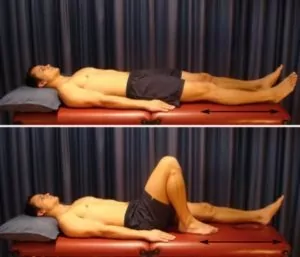
Static Quadriceps Contraction
Tighten the muscle at the front of your thigh (quadriceps) by pushing your knee down into a towel (figure 3). Put your fingers on your inner quadriceps to feel the muscle tighten during contraction. Hold for 5 seconds and repeat 10 times as hard as possible and comfortable without increasing your symptoms.
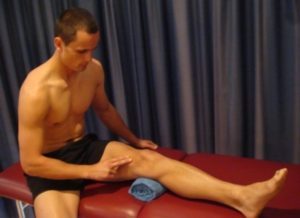
Hip Extension in Lying
Begin this exercise lying on your stomach (ideally on a bed) in the position demonstrated, provided this is comfortable and does not cause an increase in symptoms (figure 4). Keeping your knee straight, slowly lift your leg, tightening your bottom muscles (gluteals). Hold for 2 seconds then slowly lower your leg back down. Repeat 10 times on each leg provided the exercise is pain free.


Members Only ContentBecome a PhysioAdvisor Member to gain full access to this exclusive content. For more details see Become a Member. Already a member? Login Now
Intermediate Exercises

Members Only ContentBecome a PhysioAdvisor Member to gain full access to this exclusive content. For more details see Become a Member. Already a member? Login Now
Advanced Exercises

Members Only ContentBecome a PhysioAdvisor Member to gain full access to this exclusive content. For more details see Become a Member. Already a member? Login Now
Other Exercises

Members Only ContentBecome a PhysioAdvisor Member to gain full access to this exclusive content. For more details see Become a Member. Already a member? Login Now
Rehabilitation Protocol following knee arthroscopy

Members Only ContentBecome a PhysioAdvisor Member to gain full access to this exclusive content. For more details see Become a Member. Already a member? Login Now
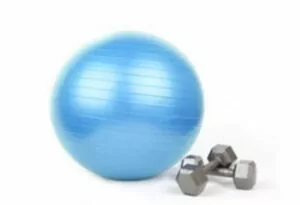 Physiotherapy products following knee arthroscopy
Physiotherapy products following knee arthroscopy
Some of the most commonly recommended products by physiotherapists to hasten healing and speed recovery in patients who have had a knee arthroscopy include:
-
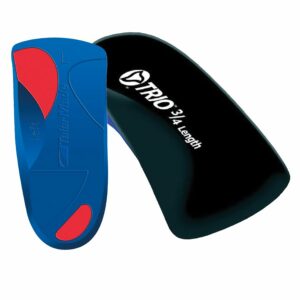 Talar Made TRIO Orthotics (3/4 length)
Talar Made TRIO Orthotics (3/4 length) -
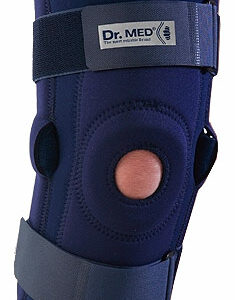 Dr Med Hinged Knee Support (Model K011)
Dr Med Hinged Knee Support (Model K011) -
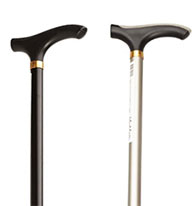 Aluminium Adjustable Walking Stick
Aluminium Adjustable Walking Stick -
 Forearm Crutches Adjustable – Standard Grip
Forearm Crutches Adjustable – Standard Grip -
 AllCare Band
AllCare Band -
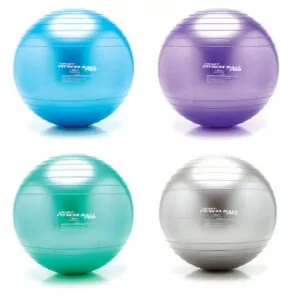 Fitness Ball Pro – Loumet
Fitness Ball Pro – Loumet -
 Premium Strapping Tape 38mm (Victor)
Premium Strapping Tape 38mm (Victor) -
 AllCare Pro-TENS Machine
AllCare Pro-TENS Machine -
 AllCare Tubing
AllCare Tubing -
 AllCare Spikey Massage Ball
AllCare Spikey Massage Ball -
 AllCare Instant Cold Pack (15 x 25cm)
AllCare Instant Cold Pack (15 x 25cm) -
 AllCare Foam Roller Round
AllCare Foam Roller Round -
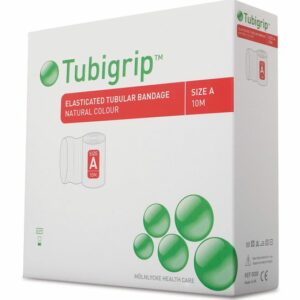 Tubigrip
Tubigrip
To purchase physiotherapy products following a knee arthroscopy click on one of the above links or visit the PhysioAdvisor Shop.
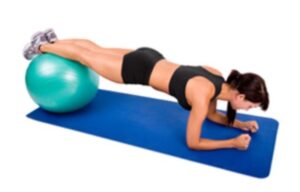 More exercises for knee arthroscopy
More exercises for knee arthroscopy
- Knee Strengthening Exercises
- Knee Stretches
- Quadriceps Strengthening Exercises.
- Quadriceps Flexibility Exercises.
- Leg Strengthening Exercises
- Leg Stretches
- Lower Body Gym Exercises (Machine Weights)
- Lower Body Gym Exercises (Free Weights)
- Cardiovascular Exercise
- Balance Exercises
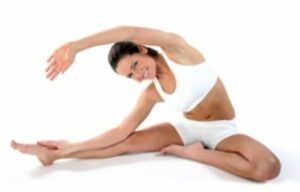 Useful information following knee arthroscopy
Useful information following knee arthroscopy
- How to use Crutches
- Knee Taping
- Patella Taping
- Ice or Heat
- R.I.C.E. Regime
- Do I Need Orthotics
- Choosing a Shoe
- Mechanical Pain
- Inflammatory Pain
- Understanding Pain
- Why is my injury not improving
- Return to Running
- Return to Sport
- Warming Up and Cooling Down
- Knee Diagnosis Guide
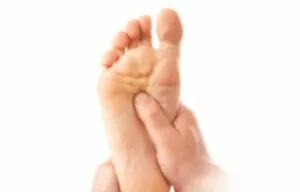 Find a Physio following knee arthroscopy
Find a Physio following knee arthroscopy
Find a physiotherapist in your local area who can treat patients following knee arthroscopy.
Become a PhysioAdvisor Member

Link to this Page
If you would like to link to this article on your website, simply copy the code below and add it to your page:
<a href="https://physioadvisor.com.au/injuries/knee/knee-arthroscopy”>Knee Arthroscopy – PhysioAdvisor.com</a><br/>Detailed physiotherapy information on knee arthroscopy including indications, symptoms, prognosis, treatment, exercises, rehab protocol, products and more.
Return to the top of Knee Arthroscopy.

